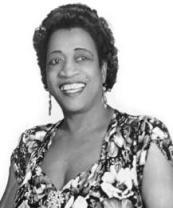Ida Cox (Ida Cox )

In 1929, Ida Cox and Crump formed their own tent show revue, aptly named Raisin’ Cain (after the biblical story of Cain and Abel and the resulting colloquialism). Cox performed as the title act, and Crump served as both accompanist and manager. Through the end of the 1920s and into the early 1930s, Raisin’ Cain toured black theaters across the Southeast and westward through Texas, with shows in Florida, Alabama, Tennessee, Texas, Missouri, and Oklahoma, and performed several times in Chicago. The show had sixteen chorus girls, comics, and backup singers. The Raisin’ Cain tent show proved so popular that in 1929 it became the first show associated with the Theater Owners’ Booking Association circuit to open at the famed Apollo Theater, in Harlem, New York. Ida Cox, sometimes billed as the “Sepia Mae West”, headlined touring companies into the 1930s. This was the pinnacle of her performing career. By the end of the decade, the economic hardships of the Great Depression and the waning popularity of female blues singers made it difficult to maintain performances of the show, with frequent layoffs and gaps in its touring schedule. Other blueswomen all but disappeared from public performance, but Cox continued her performing career through the 1930s. In 1935, she and Crump reorganized Raisin’ Cain, which by then had been renamed Darktown Scandals, and continued to tour the South and Midwest until 1939. In the early 1930s, the notable American rock-and-roll and R&B drummer Earl Palmer entered show business as a tap dancer in Cox’s Darktown Scandals revue.
The year 1939 proved to be an industrious and successful one for Ida Cox. She was invited to participate in the historic Carnegie Hall concert series From Spirituals to Swing, produced by John Hammond, in which she sang “Four Day Creep”, backed by James P. Johnson(piano), Lester Young (tenor saxophone), Buck Clayton (trumpet), and Dicky Wells (trombone), It was a highlight of the concert series and gave her performing career a much-needed boost after the Depression-era decline. Ida Cox resumed recording, with a series of sessions for Vocalion Records in 1939 and Okeh Records in 1940, with groups that at various times included the guitarist Charlie Christian, the trumpeters Hot Lips Page and Henry “Red” Allen, the trombonist J. C. Higginbotham, and the percussionist Lionel Hampton. She continued to perform until 1945, when she was forced into retirement after a debilitating stroke, which occurred during a performance at a nightclub in Buffalo, New York. She moved to Knoxville, Tennessee, where she lived with her daughter, Helen Goode, and became active in her church. Ida Cox effectively disappeared from the music world until 1959, when John Hammond placed an ad in Variety magazine in search of her. After locating her, Hammond and the record producer Chris Albertsonurged her to make another recording, and in 1961, 15 years after her last sessions, she recorded the album Blues for Rampart Street for Riverside Records, backed by an all-star group composed of Roy Eldridge, Coleman Hawkins, the pianist Sammy Price, the bassist Milt Hinton, and the drummer Jo Jones.[7] The album contained songs from her old repertoire, including “Wild Women Don’t Have the Blues”, which found a new audience, including the singers Nancy Harrow and Barbara Dane, who recorded their own versions of the song. A review in the New York Times said that Cox at the age of 65 had lost quality in range and intonation but retained her charismatic and expressive delivery of many of the classic tunes that had launched her into stardom. Ida Cox referred to the album as her “final statement”. After recording it, she returned to Knoxville to live with her daughter. She had another stroke in 1965. In 1967, she entered East Tennessee Baptist Hospital, where she died of cancer on November 10, 1967, aged 71. She was buried in Longview Cemetery, in Knoxville.
Born
- February, 25, 1888
- USA
- Toccoa, Georgia
Died
- November, 10, 1967
- USA
- Knoxville, Tennessee
Cause of Death
- cancer
Cemetery
- Longview Cemetery
- Knoxville, Tennessee
- USA

